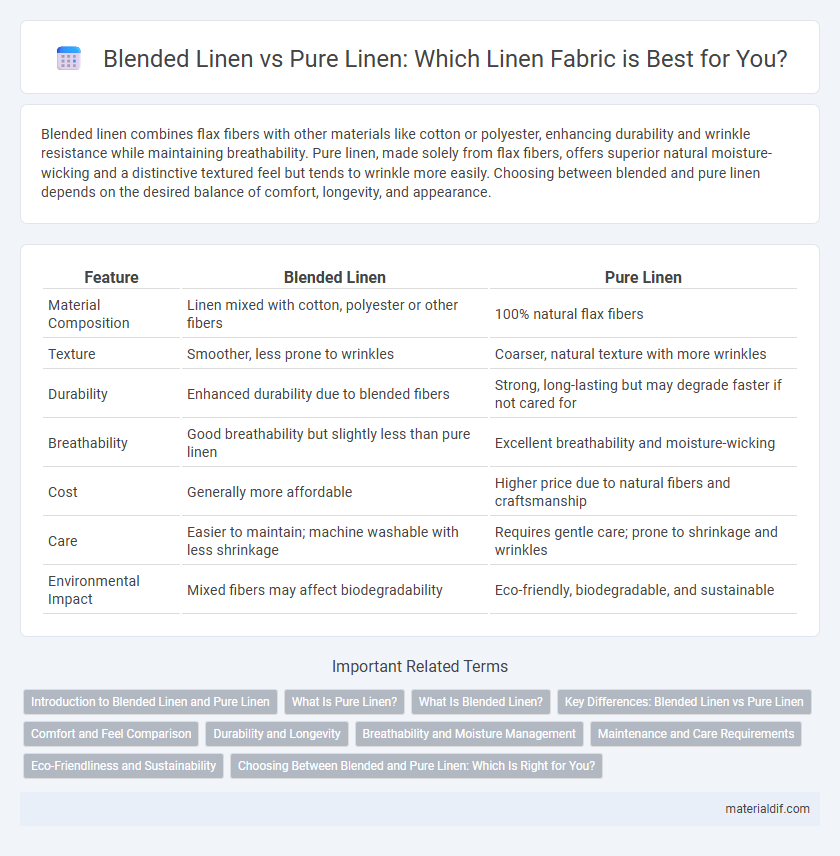Blended linen combines flax fibers with other materials like cotton or polyester, enhancing durability and wrinkle resistance while maintaining breathability. Pure linen, made solely from flax fibers, offers superior natural moisture-wicking and a distinctive textured feel but tends to wrinkle more easily. Choosing between blended and pure linen depends on the desired balance of comfort, longevity, and appearance.
Table of Comparison
| Feature | Blended Linen | Pure Linen |
|---|---|---|
| Material Composition | Linen mixed with cotton, polyester or other fibers | 100% natural flax fibers |
| Texture | Smoother, less prone to wrinkles | Coarser, natural texture with more wrinkles |
| Durability | Enhanced durability due to blended fibers | Strong, long-lasting but may degrade faster if not cared for |
| Breathability | Good breathability but slightly less than pure linen | Excellent breathability and moisture-wicking |
| Cost | Generally more affordable | Higher price due to natural fibers and craftsmanship |
| Care | Easier to maintain; machine washable with less shrinkage | Requires gentle care; prone to shrinkage and wrinkles |
| Environmental Impact | Mixed fibers may affect biodegradability | Eco-friendly, biodegradable, and sustainable |
Introduction to Blended Linen and Pure Linen
Blended linen combines natural flax fibers with synthetic or other natural materials, enhancing durability, wrinkle resistance, and often reducing cost while retaining the breathability characteristic of pure linen. Pure linen is made entirely from flax fibers, prized for its superior softness, moisture-wicking properties, and classic textured appearance, making it ideal for high-quality garments and home textiles. Choosing between blended and pure linen depends on desired fabric performance, maintenance, and budget considerations.
What Is Pure Linen?
Pure linen is a natural fabric made solely from flax fibers, known for its breathability, durability, and moisture-wicking properties. It offers a distinct texture and strength that improve with washing, making it ideal for clothing and home textiles. Unlike blended linen, pure linen contains no synthetic fibers or cotton, ensuring maximum natural fiber content and eco-friendliness.
What Is Blended Linen?
Blended linen combines natural flax fibers with other textiles like cotton, polyester, or rayon to enhance durability, reduce wrinkles, and lower costs while maintaining a linen-like texture. This fabric offers improved breathability and softness compared to pure linen, making it suitable for diverse applications in fashion and home decor. Textile manufacturers often choose blended linen for its versatility and ease of care, balancing aesthetics with practical performance.
Key Differences: Blended Linen vs Pure Linen
Blended linen combines natural flax fibers with synthetic or cotton fibers, enhancing durability, wrinkle resistance, and affordability compared to pure linen, which is made solely from flax and offers superior breathability, moisture-wicking, and a natural texture. Pure linen tends to be more expensive and requires delicate care, while blended linen is easier to maintain and retains a smoother appearance over time. The choice between blended and pure linen ultimately depends on priorities such as longevity, comfort, cost, and fabric performance.
Comfort and Feel Comparison
Blended linen combines natural flax fibers with cotton or synthetic materials, resulting in a softer texture and increased durability compared to pure linen. Pure linen, made entirely from flax fibers, offers a crisp, breathable feel that becomes softer with each wash but tends to wrinkle more easily. The comfort of blended linen suits those seeking a balance between softness and resilience, while pure linen appeals to individuals valuing natural breathability and texture.
Durability and Longevity
Blended linen combines flax fibers with synthetic or cotton materials, enhancing durability and resistance to wear compared to pure linen, which, while breathable and soft, tends to wrinkle and degrade faster over time. Pure linen, made entirely from flax, offers superior natural strength and breathability but requires more delicate care to maintain its longevity. Choosing blended linen extends fabric lifespan through increased tensile strength and reduced shrinkage, making it ideal for heavy-use textiles.
Breathability and Moisture Management
Blended linen combines natural flax fibers with synthetic or other natural fibers to enhance durability but may slightly reduce breathability compared to pure linen. Pure linen, made solely from flax fibers, excels in moisture management by absorbing and wicking away sweat quickly, keeping the skin dry and comfortable. This superior breathability and moisture-wicking ability make pure linen the preferred choice for hot and humid climates.
Maintenance and Care Requirements
Blended linen, often combined with cotton or synthetic fibers, requires less intensive maintenance, offering enhanced wrinkle resistance and easier washing compared to pure linen. Pure linen demands gentle care, including cold water washing and air drying, to maintain its natural texture and durability. Both types benefit from ironing while slightly damp and avoiding bleach, but blended linen typically withstands more frequent washing without losing shape.
Eco-Friendliness and Sustainability
Blended linen fabrics combine natural flax fibers with synthetic or cotton materials, often reducing environmental impact by using less water and energy during production compared to pure linen, which is made entirely from 100% flax fibers. Pure linen is highly sustainable due to flax's low pesticide and water requirements, biodegradability, and minimal chemical processing. Choosing blended linen textiles can offer durability and easier care while maintaining a lower ecological footprint than fully synthetic options, making both materials viable eco-friendly choices depending on specific sustainability priorities.
Choosing Between Blended and Pure Linen: Which Is Right for You?
Blended linen combines natural flax fibers with synthetic materials or cotton, offering enhanced durability, wrinkle resistance, and often a lower price point compared to pure linen. Pure linen, made from 100% flax fibers, provides superior breathability, moisture-wicking properties, and a softer texture that improves with each wash, ideal for those prioritizing natural fibers and comfort. Consider your lifestyle needs, budget, and preference for natural versus low-maintenance fabrics when choosing between blended and pure linen for clothing or home textiles.
Blended Linen vs Pure Linen Infographic

 materialdif.com
materialdif.com